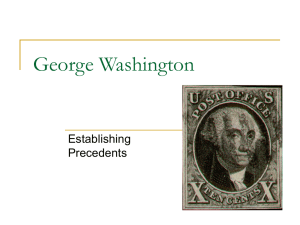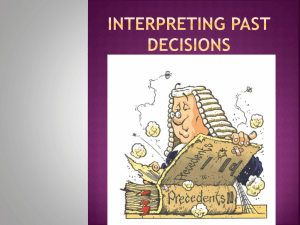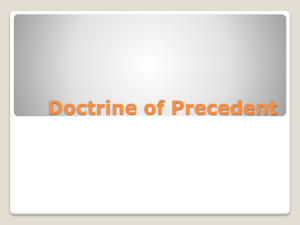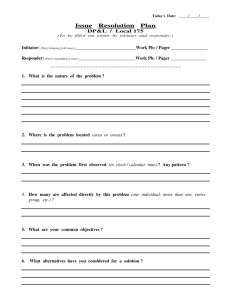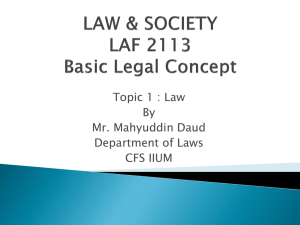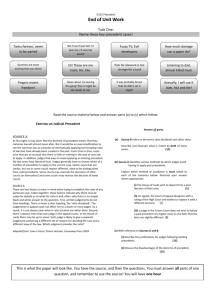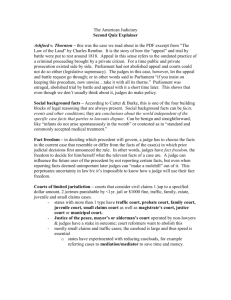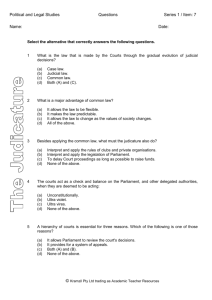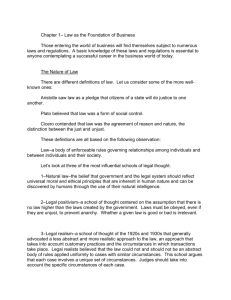statutory interpretation/doctrine of precedent
advertisement
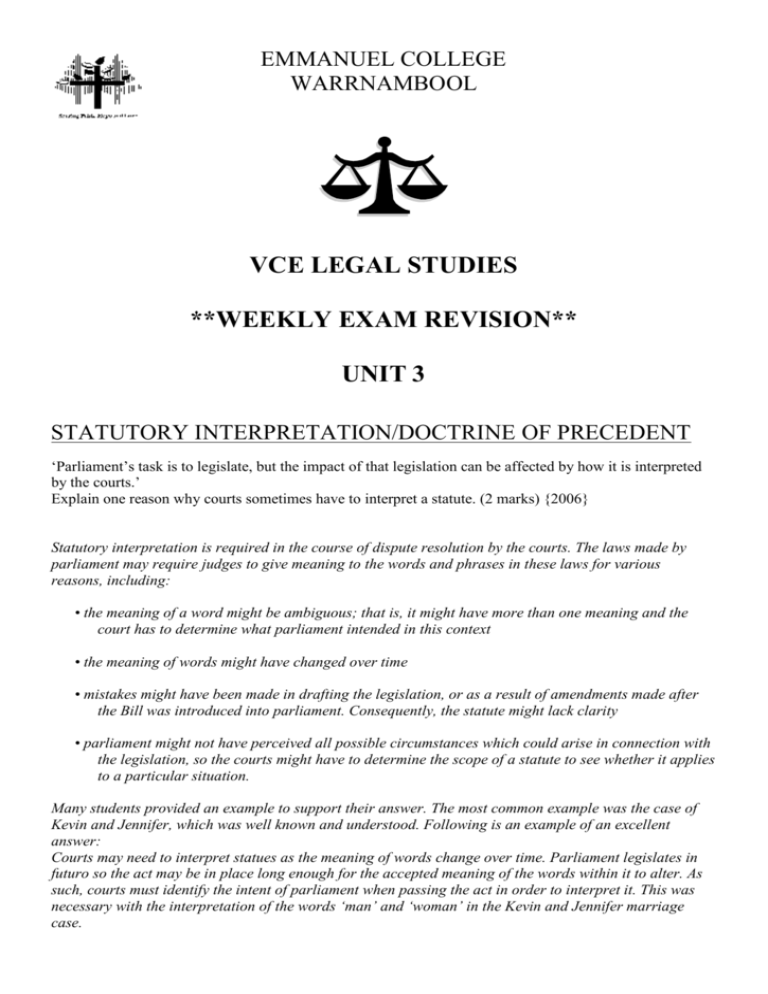
EMMANUEL COLLEGE
WARRNAMBOOL
VCE LEGAL STUDIES
**WEEKLY EXAM REVISION**
UNIT 3
STATUTORY INTERPRETATION/DOCTRINE OF PRECEDENT
‘Parliament’s task is to legislate, but the impact of that legislation can be affected by how it is interpreted
by the courts.’
Explain one reason why courts sometimes have to interpret a statute. (2 marks) {2006}
Statutory interpretation is required in the course of dispute resolution by the courts. The laws made by
parliament may require judges to give meaning to the words and phrases in these laws for various
reasons, including:
• the meaning of a word might be ambiguous; that is, it might have more than one meaning and the
court has to determine what parliament intended in this context
• the meaning of words might have changed over time
• mistakes might have been made in drafting the legislation, or as a result of amendments made after
the Bill was introduced into parliament. Consequently, the statute might lack clarity
• parliament might not have perceived all possible circumstances which could arise in connection with
the legislation, so the courts might have to determine the scope of a statute to see whether it applies
to a particular situation.
Many students provided an example to support their answer. The most common example was the case of
Kevin and Jennifer, which was well known and understood. Following is an example of an excellent
answer:
Courts may need to interpret statues as the meaning of words change over time. Parliament legislates in
futuro so the act may be in place long enough for the accepted meaning of the words within it to alter. As
such, courts must identify the intent of parliament when passing the act in order to interpret it. This was
necessary with the interpretation of the words ‘man’ and ‘woman’ in the Kevin and Jennifer marriage
case.
Explain the operation of the doctrine of precedent and evaluate two strengths of this method of lawmaking. (8 marks) {2006}
The doctrine of precedent is the set of rules that requires courts to follow precedents in order to determine
the rules of the common law. This doctrine also directs the courts regarding how these precedents are to
be followed and directs courts regarding following precedents relating to statutory interpretation. The
main points are:
• similar cases are decided in similar ways
• decisions of courts higher in the court hierarchy are binding on lower courts (doctrine of stare
decisis)
• the ratio decidendi is the part of the judgement which is binding on lower courts
• a decision of a superior court remains law until it is overruled by a higher court or altered by an Act
of Parliament
• a higher court is able to overrule the decision of a lower court in the same hierarchy
• the High Court can overrule its own decisions
• a single judge is not bound by the decision of a single judge of the same court, although such
decisions will be given considered respect
• precedents from another hierarchy are not binding but are treated as a valuable source of legal
reasoning; how persuasive they will be depends on the status of the court
• precedents from lower in the court hierarchy can also be persuasive precedents
• statements made by the judge which are not directly relevant to the point of law in question (obiter
dictum) can be persuasive
• a decision is no longer binding if reversed on appeal
• a judge can avoid following a precedent if the case can be distinguished on the facts
• through disapproving a decision, a higher court can indicate to lower courts that a decision should
no longer be regarded as good law and encourage an appeal to a superior court.
The doctrine of precedent is a challenging part of the Legal Studies course and many answers indicated
that students do not understand how this theory works in practice. Too many students argued that the
doctrine ensures that sentences or remedies are consistent, a fundamental error which must be addressed
in the classroom. In many answers, students included long descriptions of cases that have created famous
precedents (such as the ‘snail in the bottle case’); however, in many instances these examples did not
contribute to the answer. Students must consider carefully when to use an example to best effect.
The second part of the question required students to evaluate the strengths of the doctrine of precedent.
They needed to identify two strengths and look critically at these strengths, then make a judgement about
whether they are actually strengths. When looking critically at the strengths, students may have contrasted
the strength with a weakness of that method of law-making. This part of the question proved difficult for
students and further highlighted the necessity for more work developing evaluation skills.
The strengths of the doctrine of precedent include:
• a court can change a law quickly if a relevant case is brought before it
• the doctrine of precedent allows for some predictability
• courts can fill gaps in the law by making a decision on a matter when it arises
• the law is prevented from being too rigid by distinguishing, overruling and reversing previous
decisions
• the law can be expressed as a general principle (for example, the ‘neighbour test’), allowing the
courts to adapt it to fit the circumstances before the court
• judicial decisions are free from outside pressure
• the doctrine of precedent limits the possibility of prejudices or bias influencing judicial decisions
• the appeals process allows for the review of decisions
• parliament can override court-made law in the interests of representative and responsible government.
The weaknesses of the doctrine of precedent include:
• courts cannot determine what the law is unless a case is brought before the court
• courts may be bound by an old precedent which could lead to unjust results
• changes in the law are ex poste facto
• determining the law this way can be very expensive for the parties involved
• some judges are very conservative and could be reluctant to change bad laws
• judges are not elected and judges tend to be drawn from narrow socioeconomic backgrounds (though
this is changing).
The following is an introduction to a good answer.
The doctrine of precedent follows the principle of ‘stare decisis’ – to stand by what has been decided.
Precedent is a reason for a decision in the judgment of a court that sets a principle of law that must be
followed by lower courts in the same hierarchy unless the material facts of the case area so different they
can be distinguished. There are two types of precedent, binding and persuasive…
Explain the process of law-making by courts. Include in your answer and evaluation of two strengths and
two weaknesses of this process. (10 marks) {2004}
Common errors that appeared in answers to this question were that the doctrine of precedent
applies to punishments or remedies given by judges and that juries contribute to judicial
lawmaking. The sentences handed down by judges in criminal cases should not be used as
examples of the doctrine of precedent. Sentences are given on the basis of each case, victim
and offender, taking into account any sentencing legislation. The doctrine of precedent applies to
questions of law, such as, .What is murder?., or .What is a prohibited weapon?.; it does not
answer questions such as, .What punishment will be given to this defendant?. Juries answer
questions of fact, such as, .Is the defendant guilty of murder?., they do not answer questions of
law (a definition of what murder is will be provided by the judge) and therefore do not contribute
to the common law.
Most students organised their answers to this question by presenting an explanation of the
lawmaking process and then evaluating two strengths and two weaknesses; however, some
students were able to present their evaluations as they worked their way through the explanation
of the lawmaking process.
In the example provided below, the student presented an explanation and then provided a
strength with a weakness and another strength with a weakness. The answer indicates that the
student was very well prepared and had an excellent understanding of the material required by
the question.
Courts make law through the operation of the doctrine of precedent (also know as the doctrine of
.stare decisis.). This is a legal
principle that states that laws made in the superior courts of record are binding on law courts in
the same hierarchy, providing that
the material facts in the cases are so similar that they cannot be distinguished. The reason for
the decision (ratio decidendi) becomes the binding element of a precedent, not the sanction
given or facts of a case. Precedent can also be persuasive. Persuasive precedents occur when
the precedent occurred in a court on the same level (a single judge is not bound by the decision
of a single judge of the same court, although such decisions will always be given considerable
respect), in a lower court in the same hierarchy, in a different hierarchy, or obiter dictum (things
said by-the-way) in a higher court in the same hierarchy. Persuasive precedent does not need to
be followed, but may be influential. Precedent may also be made through statutory interpretation,
which occurs when a word or section of an Act of Parliament is interpreted when a dispute
concerning its meaning comes to court. The interpretation forms a precedent which is read
together with the Act in the future.
Precedents can be overruled by a higher court in the same hierarchy, this will result in the
precedent becoming .bad. law and of no effect. Lower courts that are bound by precedents can
avoid being bound if they can distinguish the facts of the case before them from the facts of the
case used as precedent; however, courts that are bound may disapprove a precedent and
therefore encourage the losing party to appeal to a higher court that is able to overrule the
precedent if they wish to. Precedents can also be reversed, or changed on appeal in a higher
court, this will also make the precedent .bad. law.
A strength of lawmaking by courts is that judges are impartial and unbiased adjudicators, are not
elected and therefore, can make
controversial laws without fear of an electoral backlash. However, this may be considered a
weakness, because judges may not take public opinion into account when making precedent or
applying an outdated precedent. Judges may tend to be conservative and leave lawmaking to
Parliament, thus applying laws that are unacceptable to the community. However, it is necessary
for judges to remain impartial in order to apply necessary laws independently.
Another strength of lawmaking by judges is that they can keep the law flexible by distinguishing,
overruling or reversing precedent. However, a precedent may not be able to be distinguished and
therefore, judges may have to apply outdated laws. This may mean that the law will become rigid
and unable to keep up with the changing social/economic demands of the community. Because
cases can only become precedents in particular circumstances, eg when in a high enough court
and when the court is willing to depart from precedents, the process of lawmaking by courts is a
slow process; however, courts have contributed huge areas of law, such as negligence, and are
a necessary part of our lawmaking process.
Other strengths could be:
• courts can fill gaps in the law by making a decision on a matter when it arises
• the a• a court can change a law quickly if a relevant case is brought before it.
Other weaknesses could be:
• changes in the law through the courts are ex poste facto
• changes through the courts are expensive for the parties involved
• Parliament can override court made law
• a dispute needs to be brought before an appropriate court.ppeals process allows for the review
of decisions

